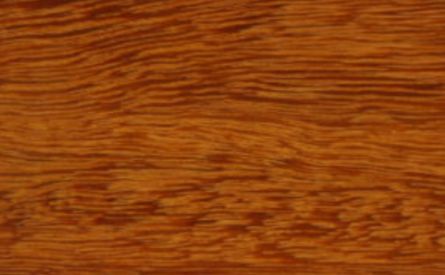BITTERWOOD
Medallo / Vatairea lundellii

Local Names
Danto, Angelim Amargoso, Faveira, Amargoso, Amargo Amargo, Arisauru, Yaksaru, Mora, Mari-Mari, Guerra, Gele Kabbes, Marupa del Bajo
Distribution & Tree
Bitterwood (bitter angelim), known as both medallo and danto in Guatemala, is widely distributed across the Neotropics, from southern Mexico, along the Atlantic region of Central America, and through Venezuela to central Brazil. It thrives in chalky and clayey soils. The tree may grow up to 30 meters, attaining diameters of 80 cm with a round buttressed trunk.
Wood Appearance
The wood is bright yellow when freshly sawn and mellows into a brown with red, yellow or olive hues as it dries sometimes with pink veins. It’s a dense timber at 750 kg/m2 with clearly demarcated sapwood and a straight or interlocked grain. It has a coarse texture. The wood has a bitter taste, inspiring the local names of faveira amargosa and palo amargo in Brazil and Mexico, respectively.
Processing Properties
Machining is good and planing is easy although raised grain during planing may occur. Slicing, turning, sanding and finishing are all good (peeling is not recommended). Nailing and gluing are good, but pre-boring is recommended. Due to its silica content (circa 0.2%), Stellite-tipped and tungsten-carbide tools are recommended. The dust during machining may affect some people.
Strength & Durability
Danto’s heartwood is quite durable and stable. Due to a moderate susceptibility to fungi and dry wood borers, treatment is recommended, especially if exposed to temporary humidification. Susceptibility is limited to its sapwood which is well demarcated.
Wood Uses
Danto is used for high-class furniture, stairs, paneling, fine and industrial flooring, formwork and sliced veneer. It can be used for exteriors, including tables, pergolas, benches, and decking. Construction uses include frames, rails, skirting boards, treads and others requiring medium to high weight-bearing strength.
Ecological & Social Importance
Bitterwood is a nitrogen-fixing species of the Fabaceae family. It thrives in chalky and clayey soils unsuited for agricultural, playing an important role in soil regeneration in degraded areas. It is also an important producer of melliferous (honey) flowers.
| Reference Species | ||||
| Technical Characteristics | Bitterwood | Sugar Maple | White Oak | |
| Density | kg/m3 | 753 | 710 | 750 |
| Janka Hardness | kgf | 634 | 658 | 612 |
| Bending Stiffness (Modulus of Elasticity) | GPa | 19.5 | 12.6 | 12.2 |
| Bending Strength (Modulus of Rupture) | MPa | 99.6 | 109.0 | 102.3 |
| Crushing Strength | MPa | 58.0 | 54.0 | 50.8 |
| Shrinkage, Radial | % | 4.5% | 4.8% | 5.6% |
| Shrinkage, Tangential | % | 7.8% | 9.9% | 10.5% |
| Shrinkage, Volumetric | % | NA | 14.7% | 16.3% |
| T/R Ratio | 1.7 | 2.1 | 1.9 | |
| Values determined at 12% humidity | ||||
|---|---|---|---|---|
DENSITY
JANKA HARDNESS
BENDING STIFFNESS
BENDING STRENGTH
CRUSHING STRENGTH
SHRINKAGE
Values are for reference only and cannot be guaranteed. Wood is a natural material and physical and mechanical properties may vary depending on age, genetics, and other factors. We encourage customers to consult the references provided in the bibliography. For further explanations of wood’s key technical characteristics, an excellent resource is the Wood Database with articles on Density (average dried weight); Janka hardness; Elastic Modulus; Rupture Modulus; Crushing Strength; Radial, Tangential and Volumetric Shrinkage.






